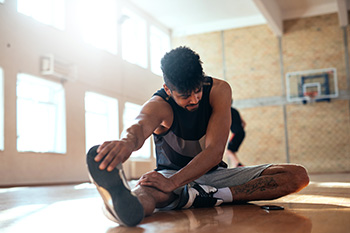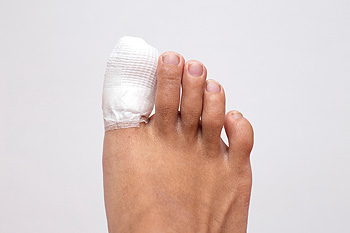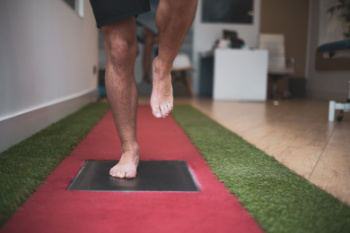Dr. Kennan T. Runte, DPM, FACFAS
Dr. Panah Nabili, DPM
Grass Valley, CA 95945
Dr. Kennan T. Runte, DPM, FACFAS
Dr. Panah Nabili, DPM

Strong ankles are vital for runners to maintain stability, prevent injuries, and enhance performance. Incorporating specific exercises into your routine can help strengthen the muscles, ligaments, and tendons surrounding the ankles. Simple exercises like calf raises, where you lift your heels off the ground and lower them back down, target the calf muscles and improve ankle stability. Ankle circles are done by rotating your ankles in both directions, which can help to improve flexibility and range of motion. Additionally, balance exercises, such as single-leg stands or using a balance board, can enhance proprioception and strengthen the ankle-stabilizing muscles. Strengthening exercises, such as toe curls and marble pickups, focus on the muscles of the foot and can contribute to overall ankle strength and stability. By incorporating these exercises into your regular training regimen, you can help reduce the risk of ankle injuries while enjoying the benefits of running for improved health and fitness. If you have an ankle injury, it is suggested that you consult a podiatrist who can treat this condition and offer you future running injury prevention tips.
Exercising your feet regularly with the proper foot wear is a great way to prevent injuries. If you have any concerns about your feet, contact one of our podiatrists of Foothill Podiatry Clinic. Our doctors will treat your foot and ankle needs.
How to Prevent Running Injuries
Many common running injuries are caused by overuse and overtraining. When the back of the kneecap starts wearing out and starts causing pain in your knee, this is commonly referred to as runner’s knee. Runner’s knee is a decrease in strength in your quadriceps and can occur if you’re not wearing properly fitted or supporting shoes. To prevent runner’s knee, focusing on hip strengthening is a good idea, as well as strengthening your quads to keep the kneecaps aligned.
What Are Some Causes of Running Injuries?
- One cause of a common running injury is called iliotibial band syndrome.
- Plantar fasciitis is also another common injury.
- Stress fractures can occur from overtraining, lack of calcium, or even your running style.
Best Ways to Prevent Running Injuries
- Wear footwear that fits properly and suits your running needs.
- Running shoes are the only protective gear that runners have to safeguard them from injury.
- Make a training schedule. Adding strengthening exercises as well as regular stretching can help keep you strong and limber and can lessen the possibility of injuries.
- Stretching keeps muscles limber; this will help you gain better flexibility.
If you have any questions please feel free to contact our office located in Grass Valley, CA . We offer the newest diagnostic and treatment technologies for all your foot and ankle needs.

Swollen feet, a discomfort many people experience, can stem from various underlying factors. Among these, poor circulation often plays a significant role. When blood flow becomes restricted, fluids can accumulate in the feet, causing them to swell. Another common culprit is prolonged standing or sitting, as this can lead to fluid retention in the lower extremities. Additionally, injuries such as sprains or fractures may trigger swelling as the body responds to the trauma. Certain conditions, including heart disease, kidney issues, and pregnancy, can also contribute to swollen feet due to fluid imbalances or hormonal changes. Moreover, lifestyle factors like excessive salt intake or wearing ill-fitting shoes can exacerbate the problem. Recognizing these potential triggers is essential in managing and preventing swollen feet. Consulting with a podiatrist for a proper diagnosis and tailored treatment is suggested for addressing the root cause of swelling and alleviating discomfort effectively.
Swollen feet can be a sign of an underlying condition. If you have any concerns, contact one of our podiatrists of Foothill Podiatry Clinic. Our doctors can provide the care you need to keep you pain-free and on your feet.
Swollen feet are a common ailment among pregnant women and people who stand or sit for extended periods. Aging may increase the possibility of swollen feet and patients who are obese often notice when their feet are swelling too. There may be medical reasons why swollen feet occur:
Swollen feet can also be caused by bone and tendon conditions, including fractures, arthritis, and tendinitis. Additionally, there may be skin and toenail conditions and an infection may cause the feet to swell. Patients who take medicine to treat high blood pressure may be prone to getting swollen feet.
Many patients elevate their feet to help relieve the swelling and this is generally a temporary remedy. When a podiatrist is consulted the reason behind the swelling can be uncovered and subsequently treated.
If you have any questions please feel free to contact our office located in Grass Valley, CA . We offer the newest diagnostic tools and technology to treat your foot and ankle needs.
 Symptoms of a broken toe typically involve immediate and severe pain at the site of the injury, which might worsen when the toe is moved or pressure is applied. Other common symptoms include swelling, bruising, and a visible deformity if the break is severe, such as the toe appearing at an abnormal angle. If the skin is broken during injury, there's also a potential for infection. Treatment for a broken toe depends on the break's severity and the fracture's nature. Treatments such as rest, elevation, and buddy taping are often sufficient for minor fractures. Sturdy and comfortable shoes are important to protect the toe during healing time. More severe cases, such as those involving a displaced bone or multiple breaks, may require a podiatrist to realign the broken bones. In rare cases, surgery may be necessary. Podiatrists may also recommend wearing a cast or a special walking boot to immobilize the toe during healing. Regular follow-ups are needed to ensure proper healing and prevent long-term complications. If you suspect a broken toe, it is suggested that you make an appointment with a podiatrist promptly for evaluation and treatment.
Symptoms of a broken toe typically involve immediate and severe pain at the site of the injury, which might worsen when the toe is moved or pressure is applied. Other common symptoms include swelling, bruising, and a visible deformity if the break is severe, such as the toe appearing at an abnormal angle. If the skin is broken during injury, there's also a potential for infection. Treatment for a broken toe depends on the break's severity and the fracture's nature. Treatments such as rest, elevation, and buddy taping are often sufficient for minor fractures. Sturdy and comfortable shoes are important to protect the toe during healing time. More severe cases, such as those involving a displaced bone or multiple breaks, may require a podiatrist to realign the broken bones. In rare cases, surgery may be necessary. Podiatrists may also recommend wearing a cast or a special walking boot to immobilize the toe during healing. Regular follow-ups are needed to ensure proper healing and prevent long-term complications. If you suspect a broken toe, it is suggested that you make an appointment with a podiatrist promptly for evaluation and treatment.
Broken toes may cause a lot of pain and should be treated as soon as possible. If you have any concerns about your feet, contact one of our podiatrists from Foothill Podiatry Clinic. Our doctors will treat your foot and ankle needs.
What Is a Broken Toe?
A broken toe occurs when one or more of the toe bones of the foot are broken after an injury. Injuries such as stubbing your toe or dropping a heavy object on it may cause a toe fracture.
Symptoms of a Broken Toe
Although the injured toe should be monitored daily, it is especially important to have a podiatrist look at your toe if you have severe symptoms. Some of these symptoms include worsening or new pain that is not relieved with medication, sores, redness, or open wounds near the toe.
If you have any questions, please feel free to contact our office located in Grass Valley, CA . We offer the newest diagnostic and treatment technologies for all your foot care needs.

In the world of running, your feet interact with the ground in various forms, each influencing performance and potential for injury. There are several types of running foot strikes, depending upon the biomechanics of your feet. One is the heel strike, where the heel makes initial contact with the ground. While common, excessive heel striking may lead to impact-related injuries. Next, the midfoot strike involves landing on the middle part of the foot. This type distributes forces more evenly and is often associated with a smoother gait. Finally, the forefoot strike, where the ball of the foot hits the ground first, reduces the impact on joints but demands greater calf strength. Each type has its merits and drawbacks, and finding the right one can vary depending on terrain and personal preference. If you are interested in a gait analysis performed to determine your running foot strike, schedule an appointment with a podiatrist.
If you have any concerns about your feet, contact one of our podiatrists from Foothill Podiatry Clinic. Our doctors can provide the care you need to keep you pain-free and on your feet.
Biomechanics in Podiatry
Podiatric biomechanics is a particular sector of specialty podiatry with licensed practitioners who are trained to diagnose and treat conditions affecting the foot, ankle and lower leg. Biomechanics deals with the forces that act against the body, causing an interference with the biological structures. It focuses on the movement of the ankle, the foot and the forces that interact with them.
A History of Biomechanics
Modern technological improvements are based on past theories and therapeutic processes that provide a better understanding of podiatric concepts for biomechanics. Computers can provide accurate information about the forces and patterns of the feet and lower legs.
Understanding biomechanics of the feet can help improve and eliminate pain, stopping further stress to the foot.
If you have any questions please feel free to contact our office located in Grass Valley, CA . We offer the newest diagnostic and treatment technologies for all your foot and ankle needs.